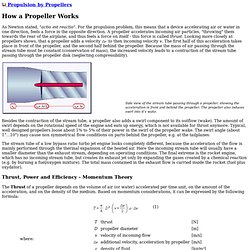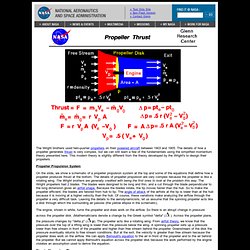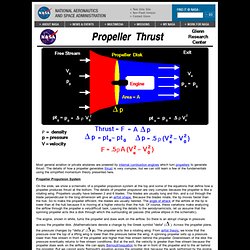

Thrust from Propellers. Thrust from Propellers. How a Propeller Works. Propulsion by Propellers As Newton stated, "actio est reactio".

For the propulsion problem, this means that a device accelerating air or water in one direction, feels a force in the opposite direction. A propeller accelerates incoming air particles, "throwing" them towards the rear of the airplane, and thus feels a force on itself - this force is called thrust. Looking more closely at propellers shows, that a propeller adds a velocity to then incoming velocity v. Besides the contraction of the stream tube, a propeller also adds a swirl component to its outflow (wake). The stream tube of a low bypass ratio turbo jet engine looks completely different, because the acceleration of the flow is mainly performed through the thermal expansion of the heated air.
Thrust, Power and Efficiency - Momentum Theory The Thrust of a propeller depends on the volume of air (or water) accelerated per time unit, on the amount of the acceleration, and on the density of the medium. Of the medium increases. Only. Propeller Thrust. The Wright brothers used twin-pusher propellers on their powered aircraft between 1903 and 1905.

The details of how a propeller generates thrust is very complex, but we can still learn a few of the fundamentals using the simplified momentum theory presented here. This modern theory is slightly different from the theory developed by the Wright's to design their propellers. Propeller Propulsion System On the slide, we show a schematic of a propeller propulsion system at the top and some of the equations that define how a propeller produces thrust at the bottom. The details of propeller propulsion are very complex because the propeller is like a rotating wing.
The engine, shown in white, turns the propeller and does work on the airflow. ). P). Simple Momentum Theory Turning to the math, from the basic thrust equation, the amount of thrust depends on the mass flow rate through the propeller and the velocity change through the propulsion system. F = [m dot * V]e - [m dot * V]0 F = delta p * A. Thrust calculation.... Propeller Thrust. Most general aviation or private airplanes are powered by internal combustion engines which turn propellers to generate thrust.

The details of how a propeller generates thrust is very complex, but we can still learn a few of the fundamentals using the simplified momentum theory presented here. Propeller Propulsion System On the slide, we show a schematic of a propeller propulsion system at the top and some of the equations that define how a propeller produces thrust at the bottom. The details of propeller propulsion are very complex because the propeller is like a rotating wing. Propellers usually have between 2 and 6 blades. The engine, shown in white, turns the propeller and does work on the airflow. ).
P). Simple Momentum Theory Turning to the math, the thrust F generated by the propeller disk is equal to the pressure jump delta p times the propeller disk area A: F = delta p * A A units check shows that: force = (force/area) * area pt0 = p0 + .5 * r * V0 ^2 pte = p0 + .5 * r * Ve ^2.